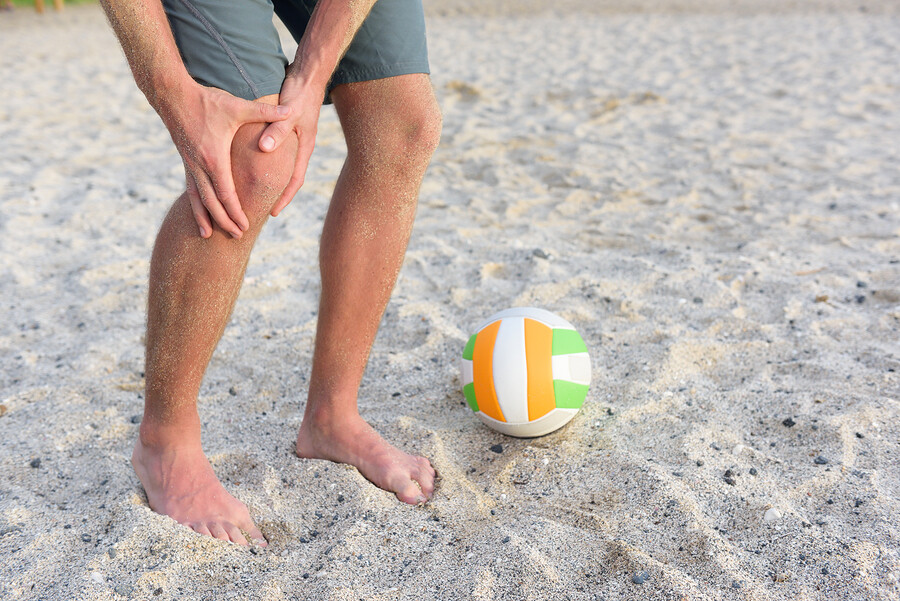Volleyball Tips for Preventing Knee Injuries

Volleyball sport itself is very competitive. The sport is particularly popular among young athletes. The game of volleyball has brought together a lot of middle school students as well as high school students all over the world.
The sport of volleyball is constantly gaining in popularity in Canada and many other countries all over the world. Both men and women choose to play the game of volleyball these days.
On the other hand, the sport of volleyball can be very traumatic. Participating in volleyball practices and volleyball games can lead to the different types of injuries. A knee injury is one of the volleyball injuries.
Volleyball players frequently jump and land on the court during games and practices. So, volleyball player’s knees as well as the muscles of knees are always under a lot of pressure. And of course, all of this increases the risk of various volleyball knee injuries.
Knee injuries are a big problem for volleyball players. The reality is, volleyball injuries of this type have long term consequences. So, it usually takes volleyball players too much time to recover from knee injuries.
In this blog, we’ll give you insights into preventing volleyball knee injuries. We’ll talk you through the most common types of knee injuries and explain how they happen. But most importantly, we’ll provide you with the tips that volleyball players need to follow to prevent knee injuries from happening.
Most Common Volleyball Knee Injuries
Knees are a part of a body that’s frequently injured during volleyball games and practices. There are different types of volleyball knee injuries. Now, let’s take a closer look at the knee injuries which frequently happen in the sport of volleyball.
Patellar tendonitis (also known as jumper’s knee) usually happens when a volleyball player jumps. The tendons that connect tibia bone to your knee cap can be damaged during a vertical jump.
If this type of knee injury happens, tendon can become irritated or strained. The injury can also results in the inflammation of the knee.
Volleyball players with this type of a knee injury usually feel pain when their knees are under pressure. They may also feel stiffness after doing physical exercises.
Luckily, the knee injury is normally treated. Among the treatment options for patellar tendonitis are:
- anti-inflammatory medication
- massage therapy
- laser treatment
- ultrasound treatment
- rehabilitation
- surgery can be required in the most difficult cases
Volleyball players must be prepared that it takes time to recover from the so-called jumper’s knee injury. So, they shouldn’t start participating in volleyball practices and volleyball competitions immediately after treatment. Otherwise, the volleyball athletes can get re-injured.
Anterior cruciate ligament injury (also known as ACL injury) happens when anterior cruciate ligament tears or over-stretches.
If a volleyball player gets ACL injury, then he/she usually experiences pain, swelling as well as discomfort when moving a knee. The injury is normally treated. Among the treatment methods that work well for ACL injury are:
- anti-inflammatory medications
- ice packs
- physical therapy
- plenty of rest
- surgery can be required in the most difficult cases
ACL injury is a big problem for volleyball players. Anterior cruciate ligament is located inside of the knee. The ACL is responsible for the proper rotation of a knee. So, athletes have to do every single thing possible to prevent such an injury.
Chondromalacia Patella is an injury that happens when damaged knee ligaments are used.
If a volleyball player gets this type of an injury, he/she feels pain when making simple knee movements such as bending knees, kneeling, squatting, walking up and down the stairs, etc.
The treatment of the affected knee consists of two stages: 1) anti-inflammatory medication as well as 2) rehabilitation.
Meniscus tears happen when the meniscus tears. This may happen due to various reasons. Volleyball players get this type of injury due to collusions, twisting of knee, etc. The meniscus tears when the knee is locked or the range of knee motion is limited.
The following methods are used for treating the meniscus tears injury:
- anti-inflammatory medication
- compressing
- icing
- resting
- surgery can be required in the most difficult cases
The meniscus plays a very important role in the functioning of a knee. The meniscus is responsible for absorbing shock in a knee.
Volleyball players should do their best to prevent this type of injury from happening. If the worst happens and an athlete gets injured, then he/she has to see a doctor and get an effective treatment as soon as possible.
How Do Knee Injuries Happen?
Volleyball players get their knees injured for various reasons. In most cases, volleyball injuries happen due to overtraining.
The athletes work hard during practices and participate in volleyball competitions. Overtraining may result in knee injuries.
It’s no surprise that the game of volleyball involves a lot of jumping. Knee injuries often happen due to vertical jumps. An athlete can get injured if he/she fails to jump in the right way.
Injuries happen due to imbalances in muscles. Volleyball players, who lack the flexibility and strength, get injured more frequently.
It’s fair to say that jumping and landing requires the body control. If a volleyball player has poor body control, then he/she can make mistakes when jumping and landing. These mistakes can result in ankle injuries.
The athlete’s schedule is very busy. Successful volleyball players attend practices and participate in various competitions. Oftentimes, volleyball players simply don’t have time to rest.
Knee Injury Prevention Tips for Volleyball Players
It’s incredibly important for volleyball players to keep their knees healthy. It’s a lot easier to prevent a knee injury than cure it and deal with its consequences.
The athletes have to take all the necessary measures to prevent knee injuries from happening. The big question is – how to prevent volleyball knee injuries? Now, let’s try to get the answer!
Volleyball players have to focus on the right type of training and do knee injury prevention exercises on a regular basis. By doing so, volleyball players will be able to prevent knee injuries from happening.
Improve Body Control to Reduce the Risk of Knee Injuries
The reality is, volleyball players can do many things to prevent knee injuries successfully. One of the best things that the volleyball athletes can do to prevent knee injuries is to improve their body control.
If you manage to improve your body control, you will be able to reduce the risk of knee injuries. It’s also important to note that doing the body control exercises positively affects volleyball serves as well as volleyball hits.
Do Strength Training to Improve Body Balance
Strength training has to be a part of a volleyball player’s training program. This type of training makes it possible for athletes to strengthen the muscles around ankles and, therefore, prevent ankle injuries.
Strength training has a positive impact on volleyball player’s balance and helps an athlete jump higher. But most importantly, strength training is a great way to prevent different types of knee injuries and perform well on the court.
Doing the exercises like lunges, squats and tuck jumps is a good way to strengthen muscles of legs and prevent ankle injuries in the sport of volleyball.
Do the Exercises that Positively Affect Athlete’s Endurance
Volleyball is the sport that requires the endurance. It’s necessary to build endurance in order to avoid ankle injuries.
There are many ways to build the endurance for volleyball. It’s recommended for volleyball players to do long distance running, ladder drills, shuttle drills as well as jumping exercises.
Lear How to Land on the Court Correctly after Jumping
In reality, the vast majority of ankle injuries happen due to the poor landing technique. That’s why it’s so important for volleyball players to develop the correct landing technique. You should always land on the court after jumping in the right way.
When landing on the court after jumping, you should have knees over toes and keep your hips back. Volleyball beginners have to put special focus on mastering a proper landing technique.
It’s something that you have to do regularly. Sooner or later, you will be able to land after jumping in the right way and this will help you minimize the risk of getting knee injuries significantly.
Thank you so much for reading this article. It goes without saying that knee injuries have a negative impact on volleyball player’s career. It takes athletes too long to recover from this type of volleyball injuries. So, they have to miss volleyball practices as well as volleyball games. Follow our volleyball training tips and take all the necessary actions to prevent knee injuries, perform well on the court and contribute greatly to your team’s success. Best of luck!
